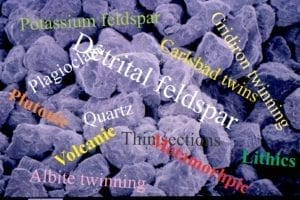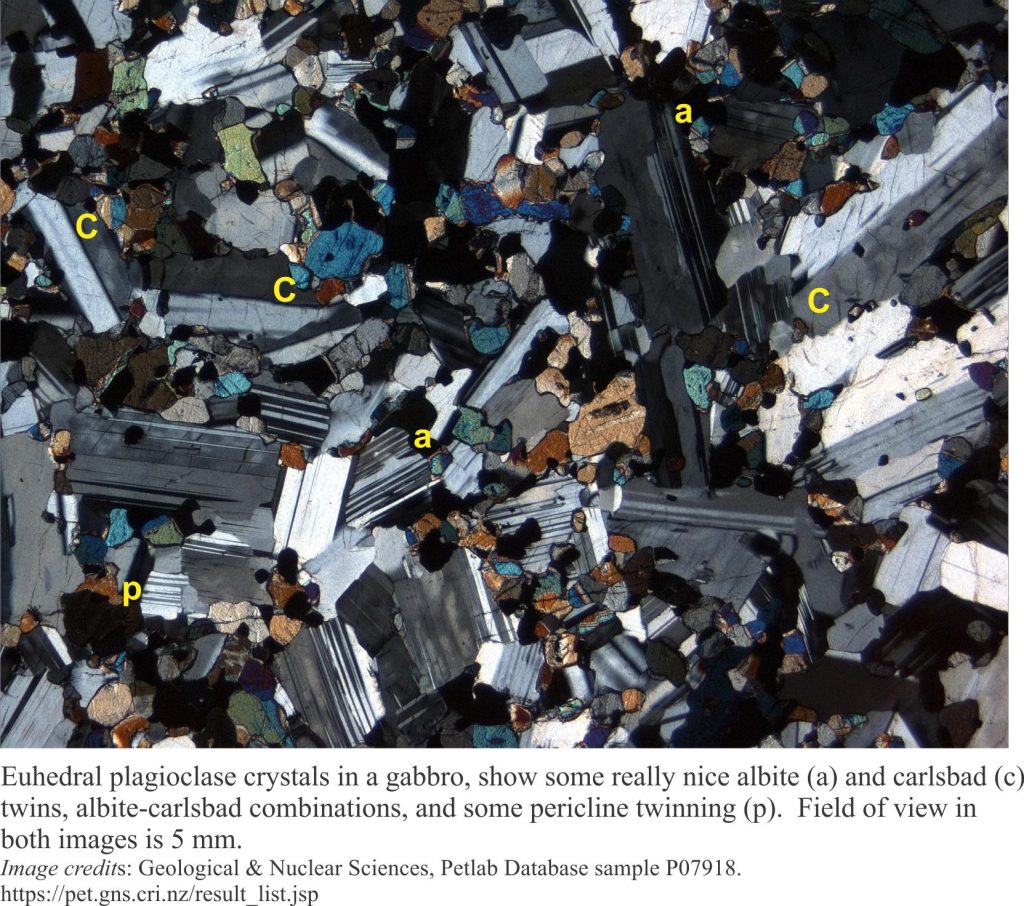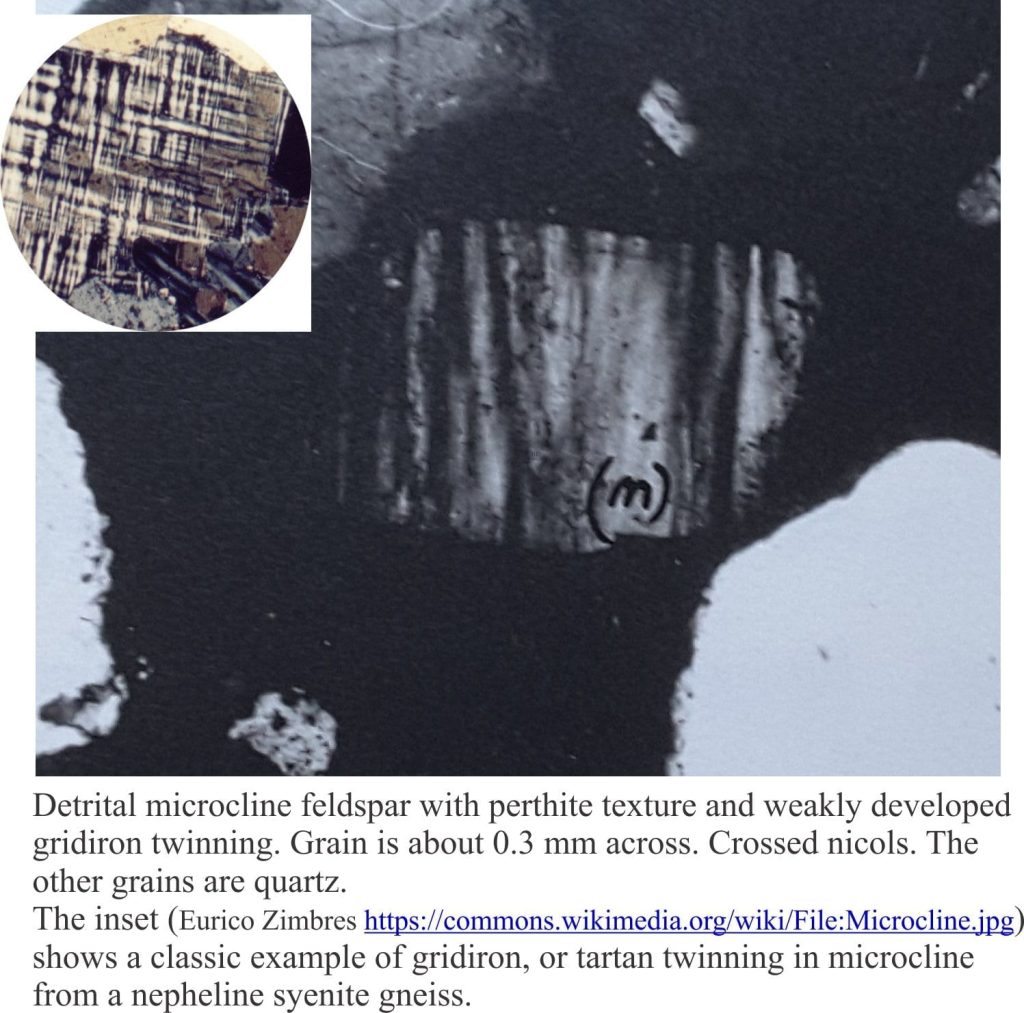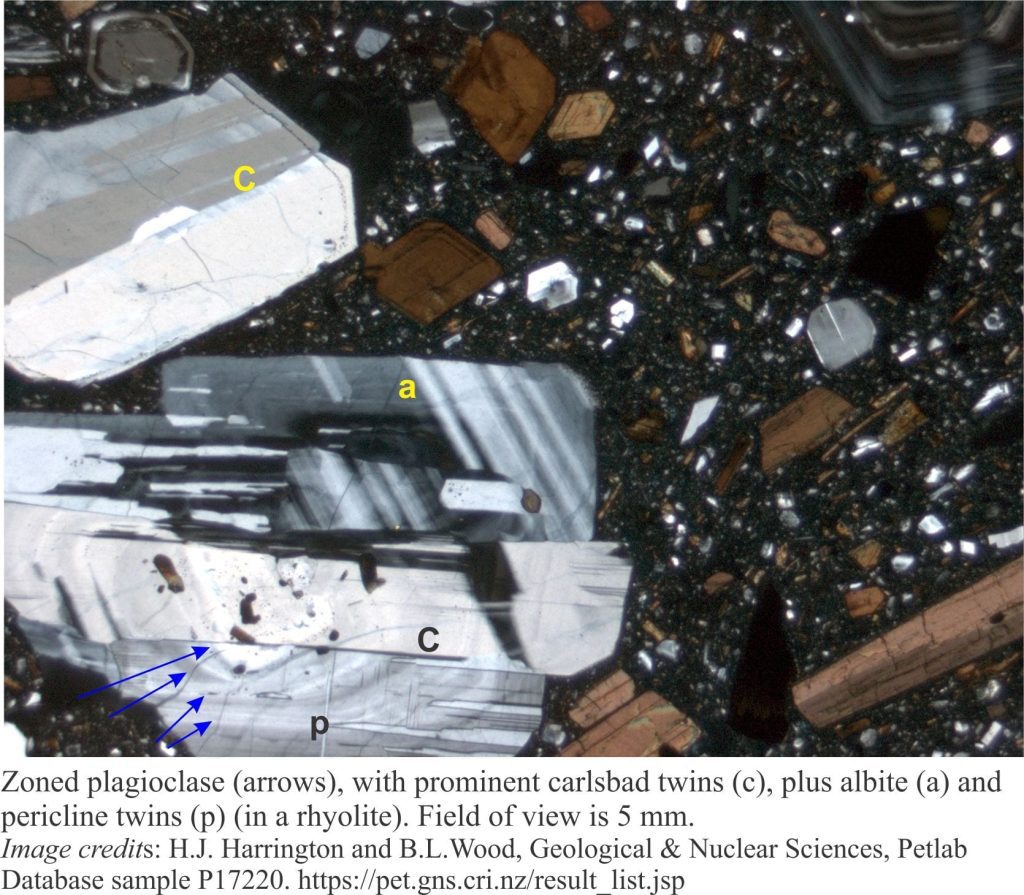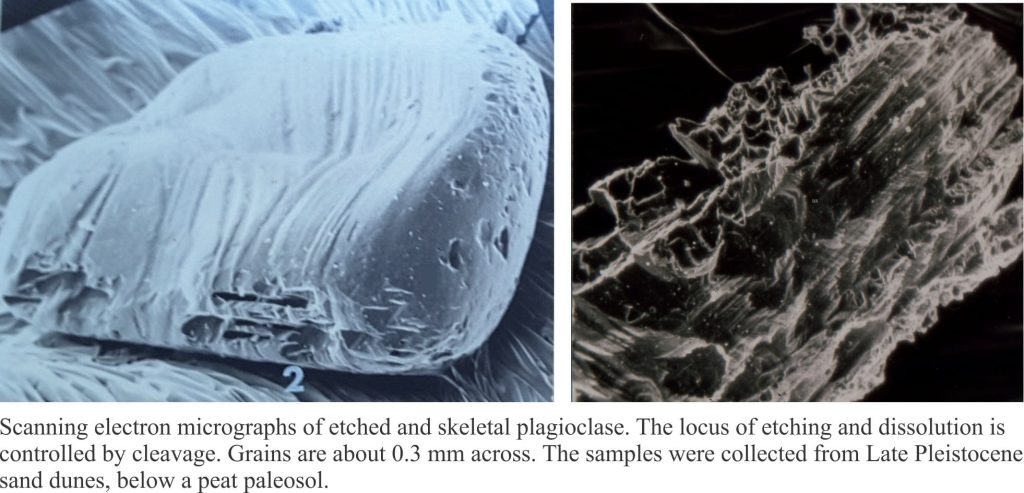Identifying detrital feldspar.
This post is part of the How To… series
Quartz may be the most common mineral in sandstone, but feldspar is the most abundant mineral in pretty well every other rock type; in fact, it is the most abundant mineral in the Earth’s crust. Unlike quartz, feldspar is an essential ingredient in nearly all igneous rocks, felsic through ultrabasic. It begins to crystallize in magmas at temperatures about 1000oC – 200o warmer than quartz crystallization. Feldspars are also common in metamorphic rocks. As such, feldspar is an important (usually subordinate) component of most terrigenous clastics, reflected in its inclusion in QFL classification schemes.
The two major groups of feldspar are potassium feldspars and plagioclases. All have low relief in plain polarized light (similar to quartz). Both groups have two good cleavage planes at 90o to each other such that broken crystal fragments tend to be blocky. Twinning is common.
Potassium feldspars all contain K and Na. Individual minerals belong to either the monoclinic or triclinic crystal systems; one variety, Adularia, can occur in both crystal forms. To complicate matters, the K-feldspars can also occur intergrown with plagioclase.
Plagioclase feldspars are also framework silicates wherein mineral definitions are based on the relative proportions of Na and Ca; the most sodic mineral is albite and the most calcic Anorthite. They form what is known as a solid solution series, which refers to the compositional continuum from Na-dominated to Ca-dominate types. Thus, the assignment of names like albite or labradorite is more or less a matter of mineralogical convenience, but a convenience that lends itself to classification of igneous rocks.
The more sodic (Na) plagioclases tend to occur in felsic volcanic and plutonic rocks like rhyolites and granites, the more calcic in basic and ultrabasic rocks such as gabbros andbasalts. Mineral identification with each feldspar group is complicated. Identification usually requires detailed optical microscopy, X-ray diffraction and/or chemical analyses. From a sedimentological point of view, we tend to lump detrital feldspars into either of the two main groups.
The main criteria used to distinguish K feldspar from plagioclases in thin sections are the different twin laws. Plagioclase is always twinned, most commonly as:
- Albite twins that display as multiple, parallel lamellae that traverse the entire crystal section. The width of twin segments decreases and the number of lamellae increases in more calcic plagioclases.
- Pericline twins are similar to albite twins but are oriented at different angles, commonly at 90o to albite twins, and
- Carlsbad twins are a kind of penetration twin with a plane that separates two crystal segments. This variety of twin can also occur in K feldspars.
Combinations of these twins are common, as shown in the examples here. Other twin laws in plagioclase do exist, but these three are the most practical for identification of detrital feldspars.
In practice, identification of K feldspars relies on two main criteria: the presence of
- Perthites which are a mix of two different exsolution feldspar phases, commonly albite and orthoclase. Exsolution occurs during crystallization from the melt, and
- Cross-hatch twins (also called gridiron or tartan twins. Gridiron twinning belongs exclusively to microcline. Here is a Youtube clip of microcline under crossed nicols.
Untwinned K feldspar, notably orthoclase, is also common in granites and granodiorites. Distinguishing untwinned orthoclase from quartz grains can be problematic, particularly if the feldspar has no obvious cleavage. Orthoclase is biaxial negative, whereas quartz is uniaxial positive but not all grains give good interference figures. Staining thin sections or polished rock slabs with sodium cobaltinitrite renders the K feldspars yellow and plagioclase red (Quartz is not affected), but this lab method can be a bit messy not the least because it uses hydrofluoric acid to etch the feldspar, and this is a particularly nasty acid.
Zoned K feldspar and plagioclase are common in volcanic rocks. Zoning commonly displays as concentrically arranged crystal growths, where the composition changes outwards from the crystal interior. Zoned feldspar may also be twinned.
All feldspars are prone to chemical and mechanical alteration by surface weathering and during burial diagenesis. Alteration products include sericite (a fine white mica similar to muscovite) and clay minerals like kaolinite. During burial diagenesis feldspar is commonly replaced by calcite and dolomite, or it may be completely dissolved resulting in secondary porosity. Authigenic albite is another product of burial diagenesis. These appear as clear euhedral crystals in carbonates and terrigenous clastics.
Feldspar is mechanically weaker than quartz (because of its cleavage) and is preferentially removed from sediment by abrasion – hence the paradox, where the most abundant mineral on Earth is subordinate to quartz in sandstones.
Some useful links in this series
The mineralogy of sandstones: Quartz grains
The mineralogy of sandstones: lithic fragments
Describing sedimentary rocks – some basics
Some useful texts:
Petrology of Sedimentary Rocks, Sam Boggs Jr. 2012
Clastic Diagenesis, D. A. McDonald and R. C. Surdam, eds., 1984. AAPG Memoir 37
AAPG Wiki– sandstones

